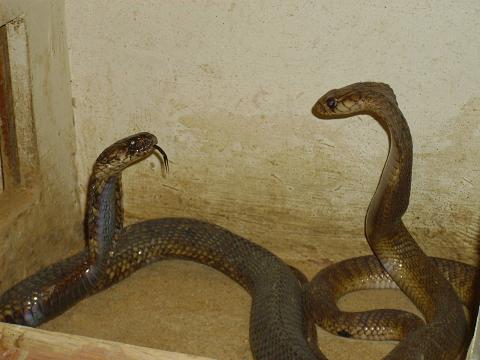|
|
|
|
|
|
|
|
|
|
Egyptian Cobra كوبرا مصرية
|

|
Class: Reptilia Order: Squamata Family: Elapidae Species:Naja haje hajeDistribution:
Egyptian Cobra ranges across most of North Africa north of the Sahara, across the savannas of West Africa to the south of the Sahara, south to the Congo basin and east to Kenya and Tanzania, and in southern parts of the Arabian Peninsula.
Habitat:
Egyptian cobra typically makes its home in dry to moist savanna and semi-desert regions with at least some water and vegetation (never in desert regions). The cobra may also be found in oases, agricultural grounds, hills with sparse vegetation, and grasslands. |  |
Description:
Egyptian cobra is one of the largest cobras of the African continent. The head is large and depressed and slightly distinct from the neck. The neck of this species has long cervical ribs capable of expanding to form a hood, like all other cobras. The snout of the Egyptian cobra is moderately broad and rounded. The eyes are quite big with round pupils. The body of the Egyptian cobra is cylindrical and stout with a long tail. The length of the Egyptian cobra is largely dependent on subspecies, geographical locale, and population.
The average length of this species is between 1 and 2 m in length, with a maximum length of just under 3 m.
Diet:
This snake preys on small mammals, lizards, toads, and other snakes, including the puff adder and Cape Cobra.
Behavior:
Egyptian cobra is terrestrial and nocturnal in the wild, though in captivity they seem to tend towards diurnally. It can, however, be seen basking in the sun at times in the early morning. It shows a preference for a permanent home in abandoned animal burrows, termite mounds or rock outcrops and the like, sometimes entering human habitations to hunt domestic fowl. It will generally attempt to escape when approached, at least for a few meters, but if threatened it assumes the typical upright posture with the hood expanded.
Reproduction:
In the wild is mating season at end of winter or beginning of summer and the babies hatch from the eggs in April and May. This season is often also the mating season in captivity but some snakes start mating in February or march and after a gestation period of 90–100 days does the female lay 10-24 eggs the eggs will hatch after 60-70 days and the babies are at birth 20-25 cm in length. The eggs need to be hatched on a temperature of 28-300C.
|
|
|
|
|
|
|
|
|
|